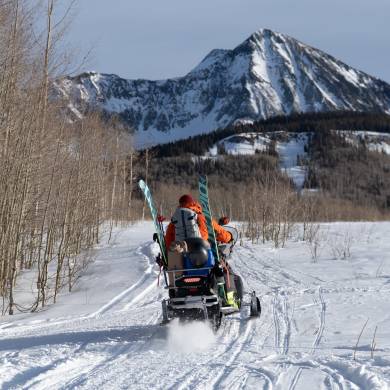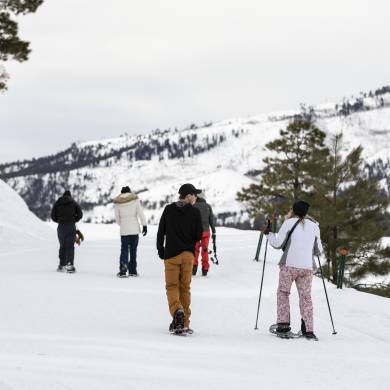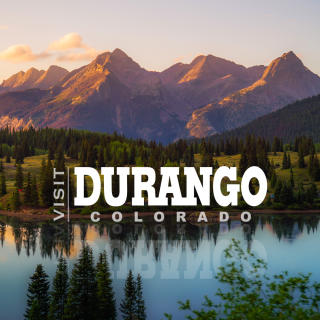Avalanche safety is something to take very seriously around the Durango, Colorado area. This area has great potential for unstable snow and can pose a high risk to skiers and snowboarders. Proper planning, training, and equipment are absolutely necessary to explore this area as safely and responsibly as possible.
This guide is meant only to introduce some of the basics for your avalanche safety arsenal. It is not intended to replace formal avalanche training safety.
For the many who decide the adventure is worth the avalanche risk, having the proper knowledge and gear will give you the best advantage and highest confidence to enjoy these beautiful parts of Durango, Colorado.
Safety Gear
Consider the following 3 pieces of safety equipment essential: beacon, shovel, and probe. All of these are equally important, as they work together in different steps of the rescue process. In order to act efficiently under high-stress circumstances, practice using your gear well before you may need it. Since you never know who in your group could become trapped, each person should carry a full equipment set, and know how to use it.
Avalanche Transceiver AKA Beacon
In the event of being buried in an avalanche, having a transceiver (AKA beacon) can help people find you — or help you find them. Beacons display an approximate distance between the victim and the searchers as well as indicate which direction to search. Some transceivers have additional features, such as revealing how many beacons are buried or the presence of vital signs.
Shovel
An avalanche shovel is the bulkiest piece of safety equipment to carry, but arguably the most powerful. It’s used for digging victims out after an avalanche as soon as possible, increasing the chance of survival. There are plenty of other ways to make use of this shovel too, such as digging pits for snow stability tests or digging a shelter.
Probes
The probe completes our three indispensable safety items. Once a beacon gives an approximate location for the victim, the probe helps zone in on the precise location, including depth. A probe helps mark the most probable area a victim is buried, which then guides where to dig. Rescues that use avalanche probes are up to 15 minutes faster than without probes - time that makes all the difference when it comes to survival.
Airbag (Recommended)
An avalanche airbag packs up relatively small but rapidly inflates into a large balloon when you pull a cord or handle. It uses the principle of inverse segregation: it makes you ‘bigger’, and bigger things tend to stay on top. As an avalanche tumbles a victim around, they are kept closer to the surface. These are some of the best investments to avoid getting buried in the first place.
Another Person for Spotting and/or Rescue
The buddy system is always a good idea when it comes to backcountry adventures — and this is no exception! Two heads are often better than one in regard to decision-making and risk assessment. And, in the event one person is buried in an avalanche, another person is there to call for help and attempt a rescue.
Know Before You Go
Avalanche conditions are constantly in flux, changing both between days and throughout the day. There are reports available to better understand and assess your desired route. It also is advised to check that area’s weather and storm warnings.
Check the Backcountry Avalanche Forecast for the South San Juans
Because this area surrounding Durango is ideal for avalanches, anyone venturing out should be trained in avalanche safety. The Colorado Avalanche Information Center puts out a daily report online that is well worth checking to avoid getting caught in high-risk conditions.
Read Through Field Observations for Southern San Juans for the Past Three Months
Knowing what lies ahead has a lot to do with what has come before. Keep an eye on field observations to note how the snow is progressing, looking for trends that could alert you to potential danger. Snow patterns are best assessed over the long-term lens of the whole winter season.
Plan a Route that Avoids Any Questionable Areas
Knowing where not to go is absolutely vital for a safe day in the backcountry. Adopting a “terrain mindset” is key here: analyze the risk factors, be willing to limit exposure to hazardous terrain, and agree on which slopes to avoid altogether. Often you can find an alternative, adjacent route at a lower angle with fewer potential consequences.
Plan an Escape for Your Selected Route
It’s important to always have a backup plan if someone gets hurt or the terrain ends up being more challenging than anticipated. The escape route should consist of lower-angle terrain with as few potential consequences as possible. Sometimes, the safest way out is the way you came in, following your skin track on the way down.
Dig a Snowpit and Perform Field Tests
Throughout the day snow conditions should be monitored regularly. Sometimes that means poking the surface with a ski pole, and other times a more involved test. A snow pit often dug about 5 feet down, is to check for significant layers in the snow which indicate areas of concern.
Extended Column Test
This test predicts both the likelihood of an avalanche forming, as well as the size it might be. Dig a pit and isolate a column (essentially a free-standing rectangle of snow) then tap it on one side to assess whether the snow next to it is affected.
Compression Test
Compression tests are used to help identify where weak layers in the snowpack exist, and how much stress they can endure before collapsing. With the blade of the shovel laid flat on top of the same snow column as above, you tap progressively harder until the column fails.
Measure Slope Angles
This is one of the best pieces of information you can collect because avalanches only happen at a specific angle (between about 30-45 degrees, most of the time). An app on your phone or an angle calculator on your pole can read the angle.
Test Beacons and Probes
Go out and practice with your beacon and probe until you are familiar with and comfortable using them. Make sure the probe can be assembled and extended correctly. For beacons, test at the beginning of the season and double-check again every time you set out.
Alternatives to Backcountry Skiing and Snowboarding
Perhaps you don’t have as much gear, knowledge, or confidence as you’d like when it comes to avalanche safety. This does not mean you need to stay indoors! There are plenty of great options for being active outside this winter which doesn’t require extensive avalanche training or equipment.
Groomed Skiing and Snowboarding at Purgatory Resort or Ski Hesperus
We are lucky to have a world-class ski resort right in our backyard with Purgatory Resort! About 25 miles north of downtown Durango you’ll find a unique blend of challenging trails and breathtaking views, with 1,600+ acres of skiable terrain. Ski Hesperus Area, just 11 miles west of Durango, boasts 26 trails with much of it illuminated for night skiing.
Cross Country Skiing
Cross country skiers delight in the plentiful options around Durango. For groomed trails check out Durango Nordic Center, Hillcrest Golf Course, and Vallecito Nordic Ski Club. If you’re looking to forge your own path on unmaintained trails, try the La Plata Canyon, Molas Pass, Old Lime Creek Rd., and Coal Bank Pass.
Snowshoeing
Many of Durango’s best hiking trails become a snowshoeing paradise in the winter. Most of the places listed above for cross country skiing also make for great snowshoeing. At some places, such as Purgatory Nordic Center, snowshoers need to use a separate trail, as other trails are groomed for skiers.
Snow Tubing or Sledding
Purgatory Resort, Hesperus Ski Area, and Chapman Hill are our top picks for tubing and sledding. All have tubes available to rent. Of course, don’t overlook your neighborhood park as a destination. Fun sledding hills are sprinkled all over town!
Conclusion
It’s no wonder why so many people feel drawn to the backcountry for skiing and snowboarding excursions. Without a doubt, it is tantalizing to the outdoor adventurer, with unspoiled slopes and sweeping views. The danger of avalanches is, however, very real. Enter the backcountry with as much thoughtful awareness and preparation as possible. Remember: there’s absolutely no shame in leaving it to pros and enjoying more tame, predictable terrain instead.




